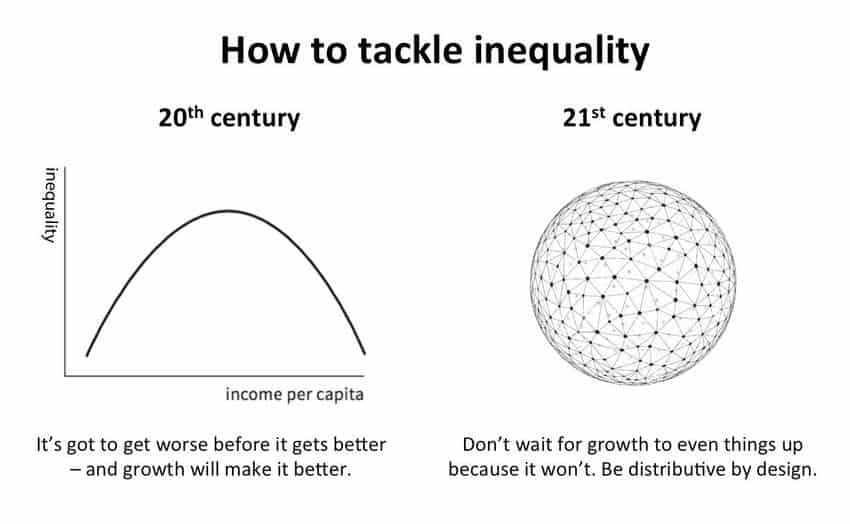The pandemic with all its suffering and shuttering has exposed vulnerabilities in our deeply entrenched economic and social system. After all, the virus fell upon us because humans ultimately encroached on the environment, spilling over a viral reservoir just like you would stir a hornet’s nest — it was bound to happen eventually and it was as nasty as (at least some scientists) expected.
But at least some cities across the world have wised up to the limitations and flaws of unbridled economic development and are looking to a new economic model to help them not only recover from the pandemic but also do so in a way that reduces the risk of another such event happening again in the future. One such model is the so-called “Doughnut Economics.”

Doughnut Economics refers to a model that meets the needs of all within the means of the planet so that we don’t overshoot Earth’s fundamental resources and offset the delicate balance of its systems. This means aiming for activities that are bound to keep the climate stable, soils fertile, or the ozone layer intact.
The term was coined by British economist Kate Raworth, author of the book Doughnut Economics: Seven Ways to Think Like a 21st Century Economist. Although a doughnut-shaped economy sounds ridiculous, the model itself makes sense and the metaphor is straightforward.
Imagine a delicious doughnut. Its hollow center describes the proportion of people who lack access to basic necessities such as food, water, electricity, healthcare, and freedom of expression. The doughnut’s outer crust is the ceiling of Earth’s life-giving systems, which we shouldn’t cross in order to preserve the climate and keep the air and water clean. The edge of the inner ring represents minimal standards for a decent life that do not compromise the wellbeing of the environment.
Between this inner ring and the doughnut’s outer crust lies the Goldielocks zone, humanity’s sweet spot where people can live fulfilling lives without overshooting the planet’s resources. The Doughnut Economic model thus serves as a model for true sustainability, one where social and economic inequality isn’t inherently built-in.
In her book, Raworth outlines several pillars of the Doughnut Economy. These are summed up in a World Economic Forum blog post authored by the British economist herself.
Land and resources: how can the value of Earth’s natural commonwealth be more equitably distributed: through land reform, land-value taxes, or by reclaiming land as a commons? And how could understanding our planet’s atmosphere and oceans as global commons far better distribute the global returns to their sustainable use?
Money creation: why endow commercial banks with the right to create money as interest-based debt, and leave them to reap the rents that flow from it? Money could alternatively be created by the state, or indeed by communities as complementary currencies: it’s time to create a monetary ecosystem that can fulfill this distributive potential.
Enterprise: what business design models – such as cooperatives and employee-owned companies – can best ensure that committed workers, not fickle shareholders, reap a far greater share of the value that they help to generate?
Knowledge: how can the potential of the creative commons be unleashed internationally, through free open-source hardware and software, and the rise of creative commons licensing?
Technology: who will own the robots, and why should it be that way? Given that much basic research underlying automation and digitization has been publicly funded, should a share of the rewards not return to the public purse?

Spurred by the pandemic, some cities across the world are taking steps towards transitioning to the Doughnut model. Amsterdam, for instance, became the first city in the world to formally implement this economic model in early April last year, during a time when the Dutch city had one of the highest mortality rates from the virus.
Amsterdam’s policymakers directly worked with the Doughnut Economics Action Lab, or DEAL, to downscale the doughnut model, which is intended as a global framework, into a city model.
The idea is to use the pandemic as a springboard for radical change so as to not return to “business as usual” if said business wasn’t working out. Some measures include new management systems for food and organic waste, as well as a new policy for consumer goods and the environment.
Besides Amsterdam, other cities across the world are embracing the doughnut economy, including Copenhagen and Brussels, as well as municipalities in Costa Rica, India, Bangladesh, Zambia, and Barbados, among others, which are currently planning out their own implementations.
If all goes well, and there is public support, the next obvious step is to transition the model nationally.


